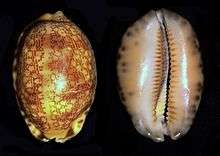Mauritia eglantina
| Mauritia eglantina | |
|---|---|
 | |
| Scientific classification | |
| Kingdom: | Animalia |
| Phylum: | Mollusca |
| Class: | Gastropoda |
| (unranked): | clade Caenogastropoda clade Hypsogastropoda clade Littorinimorpha |
| Superfamily: | Cypraeoidea |
| Family: | Cypraeidae |
| Genus: | Mauritia |
| Species: | M. eglantina |
| Binomial name | |
| Mauritia eglantina (Duclos, 1833) | |
| Synonyms[1] | |
|
Cypraea eglantina Duclos, 1833 (basionym) | |
Mauritia eglantina, the 'Dog-Rose Cowry' or 'Eglantine Cowry', is a species of sea snail, a cowry, a marine gastropod mollusk in the family Cypraeidae, the cowries.[1]
Description
These quite common shells reach on average 44–52 millimetres (1.7–2.0 in) of length, with a maximum size of 80 millimetres (3.1 in) and a minimum size of 27 millimetres (1.1 in). These cowries are rather elongated, smooth and shiny. The basic color of the dorsum is brown, with clear spots and many thin longitudinal lines. Almost in the middle of the dorsum there is a clearer longitudinal band. The base may be white, pale pink or pale brown. The edges show several brown dots. The teeth of the aperture are well developed. Mauritia eglantina can be easily confused with Mauritia arabica. In the living cowry the mantle is brown and thin.
Mauritia eglantina, side view - Philippines |
Mauritia eglantina, anterior end towards the right |
Mauritia eglantina var griseoviridis - Philippines |
Distribution
Mauritia eglantina is species of Eastern Indian Ocean and Western Pacific Ocean, ranging from eastern Polynesia and Micronesia, Samoa Islands, New Caledonia up to Southeast Asia, Indonesia, Philippines and Northern Australia.
Habitat
This species prefers rather shallow waters, lagoon reef habitats and coral rocks at 2–15 metres (6 ft 7 in–49 ft 3 in) of depth.
References
- 1 2 Mauritia eglantina (Duclos, 1833). WoRMS (2009). Mauritia eglantina (Duclos, 1833). Accessed through the World Register of Marine Species at http://www.marinespecies.org/aphia.php?p=taxdetails&id=216772 on 12 October 2010.